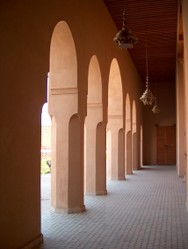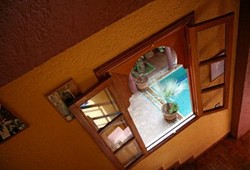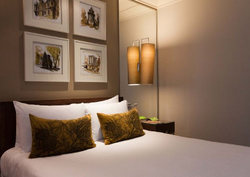The way in which Moroccan lighting is designed is not only breathtaking, but also helps to create a soothing, ethnic ambiance.
Moroccan lighting is really quite spectacular and often used to create an illusion or an atmosphere. And Just like any other form of artificial light, Moroccan lighting can also be used to create the impression of space and depth in your rooms.
The Sconce is a wall light which is available in a range of different designs and shapes. Choose from hexagons, triangular and diamond shapes, to name but a few. The various shapes ensure that light is dispersed, not only upwards, but in a number of directions. You can opt for the traditional henna sconce which is made by the Berber craftsmen and hand painted, colourful stained glass pieces, or bold brass designs.
As the sconce disperses light upwards, they are particularly effective for creating the illusion of height. Use the sconce in rooms which have low ceilings, this particular trick helps to create depth.
The stained glass designs will also throw multi-coloured light into the room which, not only helps to create a 'mood', but also casts patterns and shapes around the room. You will find that the many of the henna painted sconces are wrapped in sheepskin which casts a very soothing light. Perfect for use in rooms where the emphasis is on relaxation.

















 A Colorful Journey: Comparing and Contrasting Mexican Folk Art With Polish Folk Arton 09/05/2024
A Colorful Journey: Comparing and Contrasting Mexican Folk Art With Polish Folk Arton 09/05/2024
 Exploring Traditional Japanese Tapestry Landscape Art: A Window into Nature’s Serenityon 09/01/2024
Exploring Traditional Japanese Tapestry Landscape Art: A Window into Nature’s Serenityon 09/01/2024
 Are Border Collies Really the Smartest Dog Breed?on 08/20/2024
Are Border Collies Really the Smartest Dog Breed?on 08/20/2024
 A Writer's Guide To Wizzley- A Gem of A Bookon 04/10/2013
A Writer's Guide To Wizzley- A Gem of A Bookon 04/10/2013



Comments
The last sentence in the third paragraph to the first subheading, Moroccan mirrors, advises us that "Having said that, colours which reflect light are also used frequently, which is why many Moroccan mirrors will have silver or gold frames, helping to cast even more light back into the space."
Does it make a price difference to do gold instead of silver?
The first subheading, Moroccan mirrors, considers camel bone among characteristic materials.
Does camel bone defer to other woods or does it dominate?
This week I have been reading a book about Celtic illustrated manuscripts.
That book indicates that the aforementioned manuscripts invoked blue and red jewels on their covers and blue, green and gold-painted pages.
Moroccan mirrors and sconces muster such colors.
The above occurrences tend me toward those colors as sacred westerly.
Would your product-line searches have come across mirrors and sconces in Buddhist and Hindu traditions? Wouldn't it be interesting if similar colors and designs wended their way to those host countries?
It's quite compelling to itinerate from your Moroccan interior design to your wizzleys on Moroccan mirrors and sconces and on tagine pots and vice versa.
Is there pottery on par with tagine pot colors, designs and shapes to inch into courtyard spaces and interior rooms and under mirrors and sconces?
Your wizzlies elucidating Moroccan mirrors, Moroccan interior design and tagine pots enchant me.
Moroccan mirrors in Moroccan interior-designed dining rooms, kitchens, porches and snack bars particularly furnish favorable thoughts of fun food.
Now what Moroccan food might muster the most memorable, munchable looks, scents and tastes in such a marvelous milieu?
Might you and your sister have some Moroccan recipes?
Your article on Principles of Moroccan interior design; how to transform your living space into an exotic retreat contains among its comment boxes your observation Oct. 2, 2012, that "I visited Marrakech a couple of years ago and fell in love with the colours and designs. I also recently helped my sister re-decorate her house in the Moroccan style, it is so beautiful. Now her's is complete I'm starting on my own home, bathroom first, then the remainder of the rooms!"
Did you incorporate any of the above lighting arrangements and rationale into your and your sister's houses?
The second paragraph to the third subheading, Moroccan Lanterns, Sconces and Table lamps, advises that "The Sconce is a wall light which is available in a range of different designs and shapes. Choose from hexagons, triangular and diamond shapes, to name but a few" and that "You can opt for the traditional henna sconce which is made by the Berber craftsmen."
Why does the traditional sconce have the designation "henna"?
You wizzley can be characterized as a most welcome elucidatingly anthropological, cultural, philosophical approach to a product line!
Your first subheading, Moroccan mirrors, considers in its first paragraph camel bone, wood and wrought iron as traditional supports to their mirrors.
The third paragraph explains that "The craftsman may use a range of colours when painting the mirror's frame or doors, it's not uncommon to find hues of red or green or blue together. Having said that, colours which reflect light are also used frequently, which is why many Moroccan mirrors will have silver or gold frames, helping to cast even more light back into the space."
The article Exploring the rich colour palette of Morocco by Katie Dalrymple-Hamilton Feb. 19, 2024, for Exceptional Travel, features as religious colors black, blue, green, ochre, red and white.
Camel bone guards the religious color white, for cleanliness, purity and spirituality of mosques and religious ceremonies.
Might wood and wrought iron qualify as spiritually-colored black?
The aforementioned article reveals nothing about the religious-color symbolism of black even as other internet sources refer to that color as the ultimate divine-ness because of the colorlessness of their God!
The article Exploring the rich colour palette by Katie Dalrymple-Hamilton Feb. 19, 2024, for Exceptional Travel Ltd. accounts for nature- and urban-based redness in Morocco color schemes.
Red aestheticizes Marrakech, acknowledged as Morocco's red city of terracotta hues and of red sandstone walls around its medina. Nature applauds the country's red soils so amenable to building and farming activities.
The above-mentioned article associates the religious colors of green, white and yellow with Islamic color script and symbolism even as it avoids such associations with the four other -- black, blue, ochre, red -- religious colors.
Did she divulge such details elsewhere, in another article at another time? Hope, hope!
The article Exploring the rich colour palette of Morocco by Katie Dalrymple-Hamilton Feb. 19, 2024, for the Exceptional Travel website associates green with the “religious colours” in religious buildings.
Its author explains that animal and people images never enter into Islamic decorations, that Islam instead features colors, scripts and symbols.
Dalrymple-Hamilton gives black, blue, green, ochre, red and white as the historic six colors for religious buildings. She heeds green as the fertility-, growth-, prosperity-heralding color of paradise and of the Prophet Muhammad. She indicates that the King’s Palace, the important mausoleums and the mosques inspire green roofs and that city and town traditional buildings invoke green ceramic tiles and mosaics.
The above meanings and traditions might motivate green colors in Moroccan mirrors, mightn’t they?